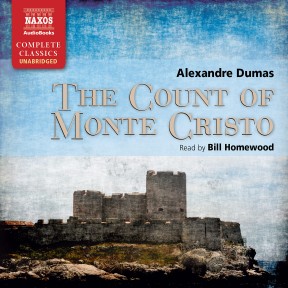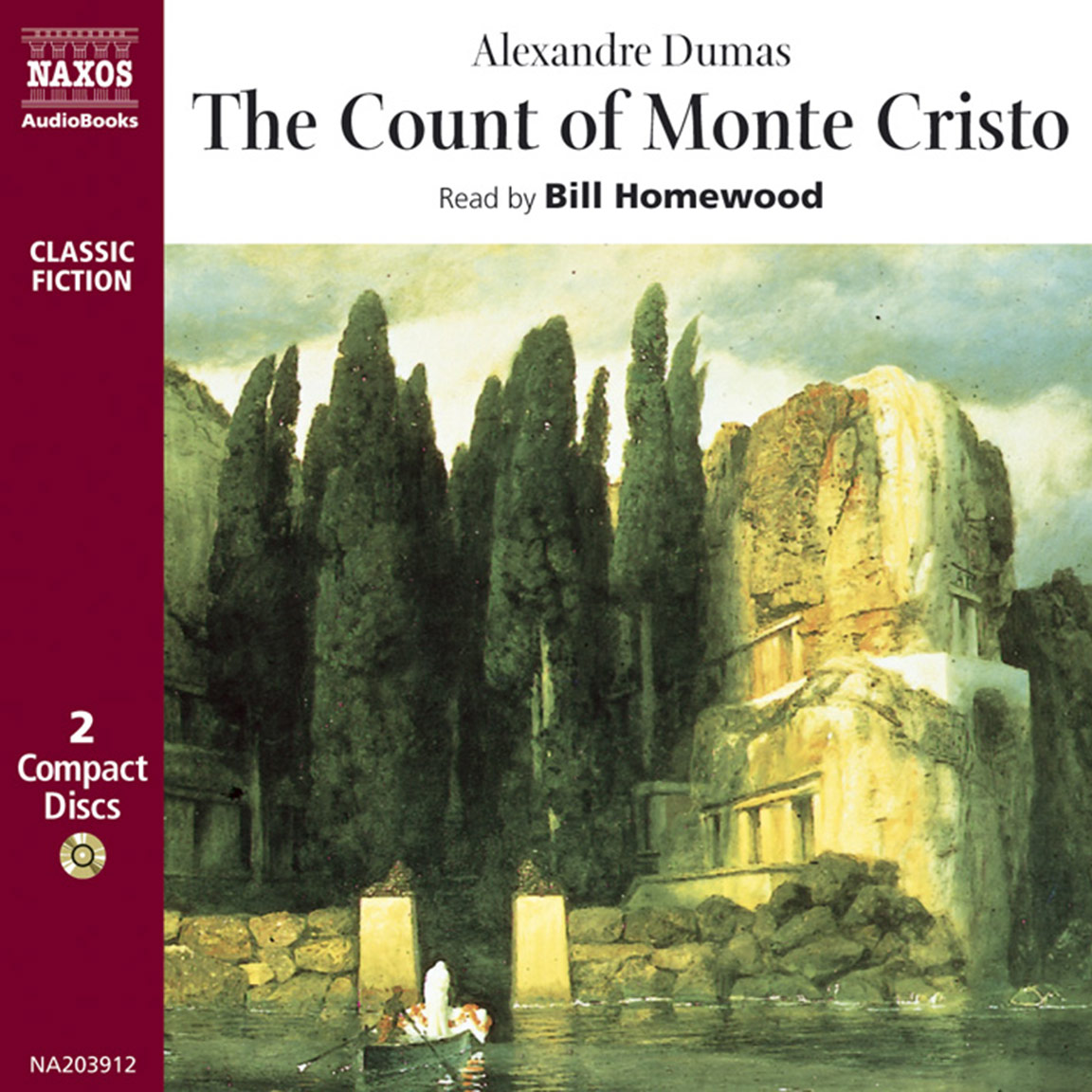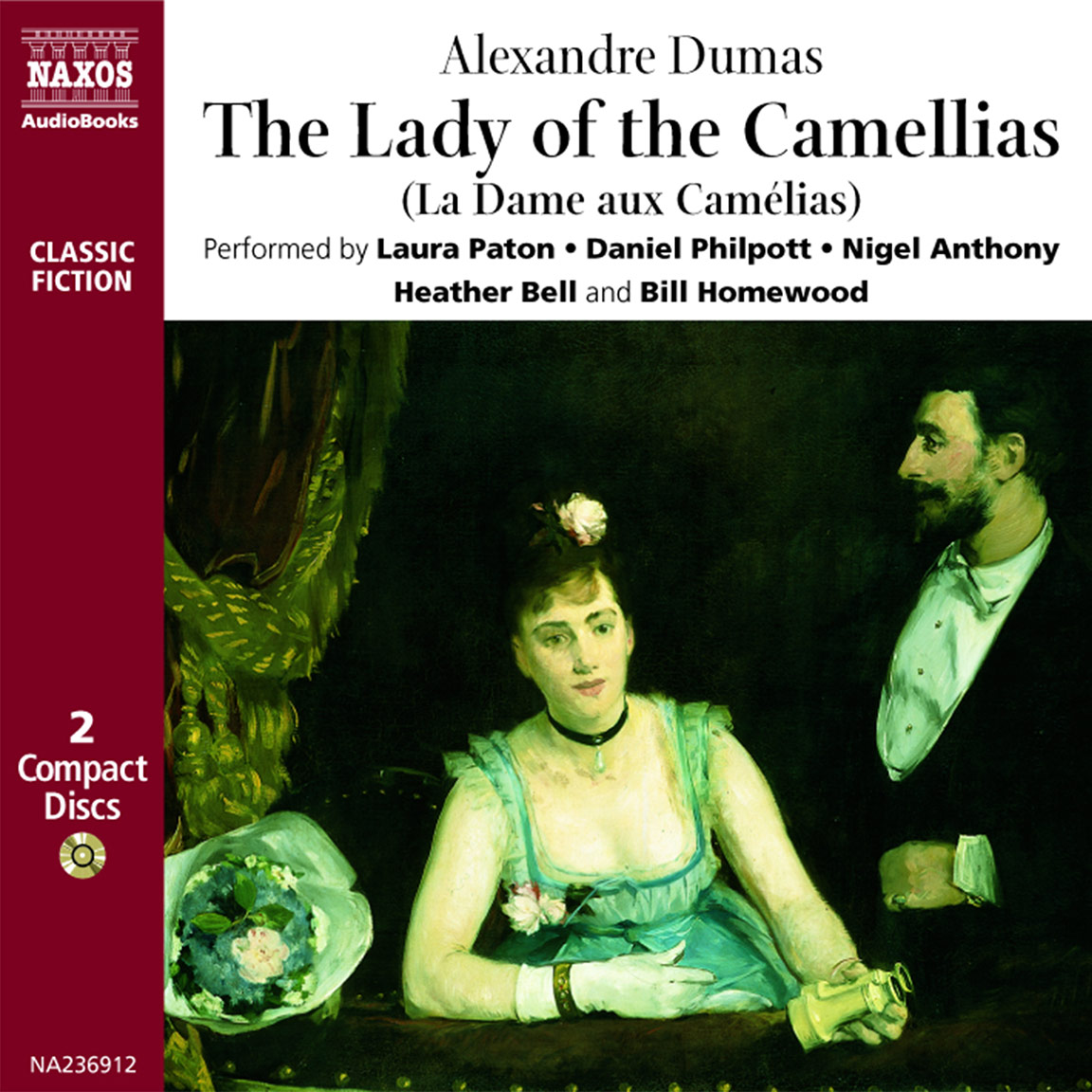
Audio Sample
Alexandre Dumas
The Count of Monte Cristo
Read by Bill Homewood
unabridged
On the eve of his marriage to the beautiful Mercedes, having that very day been made Captain of his ship, the young sailor Edmond Dantès is arrested on a charge of treason, trumped up by jealous rivals. Incarcerated for many lonely years in the isolated and terrifying Chateau d’If near Marseille, he meticulously plans his brilliant escape and extraordinary revenge. Of all the ‘Masked Avengers’ and ‘Caped Crusaders’ in literature, the Count of Monte Cristo is at once the most daring and the most vulnerable. Alexandre Dumas (père), master storyteller, takes us on a journey of adventure, romance, intrigue, and, ultimately, redemption.
-
41 CDs
Running Time: 52 h 41 m
More product details
ISBN: 978-962-634-134-6 Digital ISBN: 978-962-954-938-1 Cat. no.: NAX13412 Download size: 769 MB BISAC: FIC004000 Released: July 2010 -
Listen to this title at Audible.com↗Buy on CD at Downpour.com↗Listen to this title at the Naxos Spoken Word Library↗
Due to copyright, this title is not currently available in your region.
You May Also Enjoy
Reviews
If you are already dismayed by the length and price of this famous story of revenge set in France against a backdrop of turbulent Bonapartist politics, you could cop out and buy the two-CD abridgement for £10.99. It would be about as satisfying as booking a table at Le Gavroche and ordering scrambled eggs, but 52 hours, I agree, is a long haul. Dumas père is chiefly remembered for this, for The Three Musketeers, and for fathering Alexander Dumas fils, author of La Dame aux Camélias. It’s a terrific story. Edmond Dantès, a charismatic young seaman, just promoted to captain, is framed by jealous rivals, falsely accused of being a pro-Bonaparte spy and arrested minutes before his marriage to the beautiful Mercedes. He is sentenced to life imprisonment at the notorious Château d’If, where, 14 years later, a fellow inmate, a priest on his deathbed, reveals the whereabouts of a massive treasure on the tiny island of Monte Cristo. Dantès escapes, finds the treasure, buys a peerage and sets about his revenge. Take it on your gap year.
Sue Arnold, The Guardian
The Count of Monte Cristo is an extraordinary, long, complex work with a very simple story idea: a young man is horribly wronged, emerges from prison with a new life and a vast fortune, and uses that plus his very good mind to wreak vengeance on the people who ruined his life. It’s fantastic, in every meaning of the word; it’s different from what I expected and from nearly everything I’ve read before; it’s a great adventure yarn with a lovely little romance thrown in (almost entirely counterbalanced by wrecked relationships, but still lovely)… In fact…
‘Has it got any sports in it?’
‘Are you kidding? Fencing, fighting, torture, revenge, giants, monsters, chases, escapes, true love, miracles…’
The giants and monsters are figurative in The Count, but they’re in there – they are in there. There’s actually very little fencing or fighting, and the torture is almost all mental, but… yeah. It’s all there.
The story is, at its heart, very simple. A strong and handsome and capable young man is well on his way to having a golden life, complete with the girl he loves, until jealousy in those around him has him sent to prison on false charges. There he sits for seventeen years as the world spins on without him, his only relief from the dark solitude a fellow prisoner who takes him on a mad journey to escape, teaching him everything he could ever need to know about everything while they work at it. When he finally does escape, he embarks on a mad quest of his own, to have a subtle, vicious revenge on everyone who harmed him.
I listened to the Audible audiobook read by Bill Homewood, and had a wonderful time – he made 52 hours and 45 minutes seem like only four days.
No, I kid – he gave a magnificent performance. The audiobook I chose for a Goodreads Buddy Read of The Count of Monte Cristo – narrated by Bill Homewood – is in 6 parts, totalling 52 hours & 45 minutes. In other words, two days, four hours, and forty-five minutes. Funnily enough, other versions were of wildly varying lengths – unabridged editions run between 45 hours and the one I picked, 52 hours and 45 minutes. There were also several abridged editions – from a dramatic presentation lasting an hour (how??) to a 17 hour abridgement – but despite its being the longest out there I liked the sample of this, and I think it was a good choice: Mr Homewood is an excellent companion. I can only assume some translations were more succinct than others, or that where Mr Homewood uses a different (extremely well done) voice for each character (resulting in different cadences), and gives each line its full dramatic weight, someone reading in one level tone might get through the material more quickly. For me a big part of the enjoyment was listening to the performance – he went all out on it, conveying real emotion and suspense and humour and dread in a magnificent one-man show. He deserves an award. Most actors’ performances are one character in some fraction of a film or play or TV episode between one and three hours; this was 100% of nearly 53 hours, and fantastic. (I spent no little time marvelling at how he kept the voices straight. I would be doing constant re-takes after reading Danglars’s lines in Villefort’s voice or some such.) (Not to mention the occasional cut to edit out my frustrated exclamations of ‘Wait, who the *&$! is THIS, now??’)
Stewartry, agoldoffish.wordpress.com
Booklet Notes
And now farewell kindness, humanity and gratitude! Farewell to all those feelings which nourish the heart! … Now may the God of Vengeance yield to me his power to punish the wicked!
With these words the sailor Edmond Dantès, soon to become ‘The Count of Monte Cristo’, embarks on a journey of revenge.
As a young man, the world had been at his feet. Noticed for his great skill and authority at sea, he had just been promoted to Captain by his grateful patron; he was about to marry his love, the beautiful Mercedes from a nearby Catalan village, and was at last to have the means to take care of his beloved, ageing father. Taken summarily from the pre-nuptial celebration and arrested that night on a trumped-up charge of treason, he has spent many years languishing in a dungeon of the dreaded Chateau d’If, built on a rock near the port of Marseille. During that time, always grieving at the loss of Mercedes, always anxious about his old, weak father, he has not only planned an ingenious escape and plotted a terrible vengeance against the cabal of jealous conspirators he had believed to be his friends, but, with the help of a learned Abbé imprisoned in an adjoining cell, he has also become expert in many things: history, philosophy, chemistry, medicine, languages and literature. In addition, he has become the master of disguise and has learnt to appreciate artistic beauty in all disciplines with an expert’s eye. Now free, and, thanks to the Abbé, with secret access to unlimited wealth, he rejects ordinary compassion, and, like Shakespeare’s Lady Macbeth, dehumanizes himself, becoming invulnerable to pity or remorse, before gathering around him a loyal crew of men and setting out on his odyssey of revenge.
It is rare in dramatic literature for the novelist simply to chart the battering-about by Fate of the hapless central figure. It can be done – Dickens’s Nicholas Nickleby and Swift’s Gulliver’s Travels, for example, are nonetheless compelling reads, in which the breathless reader usually knows more than the hero at any given point. However, most romantic heroes are in pursuit of a goal. Countless examples spring to mind: Homer’s heroic Odyssey, charting Odysseus’ long journey home, Cervantes’ ludicrous Don Quixote on a quest for romantic love, Voltaire’s naive Candide in search of ‘the best of all possible worlds’, Bunyan’s The Pilgrim’s Progress, among others. These are heroes with an agenda, who push the plot along on their own terms. The Count of Monte Cristo is one such. His agenda is clear, and linear: revenge.
it is Monte Cristo’s
final, decisive act
of true love and
loyalty to one
woman which redeems
him for us
The ‘God of Vengeance’ has an almost pagan ring to it. With his talent for observational psychology, Dumas manages somehow to reconcile the Count’s tender, compassionate nature with his darker side. Attending a public execution in the Piazza del Popolo in Rome, Monte Cristo is at his most bizarre:
The count alone seemed unmoved – nay, more, a slight colour seemed striving to rise in his pale cheeks… His nostrils dilated like those of a wild beast that scents its prey, and his lips, half opened, disclosed his white teeth, small and sharp like those of a jackal. And yet his features wore an expression of smiling tenderness… his black eyes especially were full of kindness and pity.
The detail is horrific, as Dumas takes us close to the scaffold:
The criminal strove to rise, but, ere he had time, the mace fell on his left temple. A dull and heavy sound was heard, and the man dropped like an ox on his face, and then turned over on his back. The executioner let fall his mace, drew his knife, and with one stroke opened his throat, and mounting on his stomach, stamped violently on it with his feet. At every stroke a jet of blood sprang from the wound…
… The count was erect and triumphant, like the Avenging Angel!
Yet Monte Cristo describes himself as an ‘emissary of God’. Indeed, his cold revenges are leavened with great acts of kindness and generosity. Towards the end of his novel, his invulnerability to the pain of others, and his belief in himself as a Godly agent of justice, are both challenged when the unexpected death of a child shows us, for the first time since the early chapters, the ‘human’ and almost Christian face of the man:
Monte Cristo became pale at this horrible sight; he felt that he had passed beyond the bounds of vengeance, and that he could no longer say, ‘God is for and with me.’ With an expression of indescribable anguish he threw himself upon the body of the child…
Perhaps the Old Testament ‘God of Vengeance’ had become the New Testament ‘God of Forgiveness’? The Count is forensically fascinated by compassion and revenge, increasingly examining these instincts in himself as in others. Well into the book, in a discourse on ‘conscience’ he says:
After every action requiring exertion, it is conscience that saves us… Richard III, for instance, was marvellously served by his conscience after the putting away of the two children of Edward IV… Thus was Lady Macbeth served by her conscience… Ah, maternal love is a great virtue, a powerful motive – so powerful that it excuses a multitude of things, even if, after Duncan’s death, Lady Macbeth had been at all pricked by her conscience.
As Monte Cristo is addressing a murderess here, there may be dramatic irony in the speech, but it is forged through with sincerity. As he ages, and – piece by piece, ever changing his disguise, his dialect, even his language – calculatedly achieves his aims, we are moved by his reflections on justice, by his developing conscience and exponential philosophical growth and by his increasing humility. In Les Misérables, Victor Hugo gives us the exemplary, heroic, ever-humble, almost Christ-like Jean Valjean, and his sworn pursuer and tormentor Javert. In Dumas’ The Count of Monte Cristo, we have the Avenger and the Conciliator in one man, though the journey from the one to the other is hard-won. Late in the book, Monte Cristo describes himself as:
… a man who like Satan thought himself for an instant equal to God, but who now acknowledges with Christian humility that God alone possesses supreme power and infinite wisdom.
However, despite these surprising flashes of vulnerability which Dumas is at pains to include, despite the Count’s stupendous acts of kindness to deserving friends, and despite our sympathy for the betrayals and subsequent dreadful agonies he has endured, in the end it is Monte Cristo’s final, decisive act of true love and loyalty to one woman which redeems him for us, which brings goose-pimples to our skin and makes this thrilling book difficult to close even after we have read the last words. This may well be because we know that, for the first time in his life since the terrible betrayal which led to his odyssey of revenge, the Count is happy.
The Count of Monte Cristo, in spite of its high literary quality, has the same power to thrill as any classic adventure in which the villain gets his come-uppance, the hero is rescued in the nick of time and good fortune comes to those who deserve it. The 20th century has produced its own mysterious masked saviours both in literature and on-screen – the best-known among them The Lone Ranger, Zorro, Batman and Superman. Monte Cristo was perhaps the pre-cursor of them all: the first ‘Caped Crusader’ or ‘Masked Avenger’.
Alexandre Dumas wrote or collaborated on nearly 100 plays and many novels, including the celebrated The Three Musketeers and the follow-up The Man in the Iron Mask. He was born in 1802, the son of a general in Napoleon’s army and the grandson of a French Marquis and a black woman from Saint Domingo. As a child he lived through the upheavals of the Napoleonic Revolution and the subsequent restoration of the French monarchy, which form the political background to the novel. Interestingly, like Monte Cristo, Dumas received his private education from a priest. He was politically active and, though he is thought to have embellished the actions in his Mémoires, was involved heroically in skirmishes during the revolution of 1830. He was the father of author Alexandre Dumas (fils), most famous for his La Dame aux Camélias.
Alexandre Dumas (père) ran his career as an industry. Following the model of many of the great master-painters, it is believed that he would sketch the outline of a story to an assistant who would write it up; then Dumas himself would take the story by the throat and wrestle it into a masterpiece. His compulsive storytelling, fascinating background research, brilliant characterization and unfailing, lyrical powers of description are unrivalled.
He was an idiosyncratic man who cooked brilliantly, gave a lot of money to cadgers and hangers-on and spent prodigiously on his private life, most notoriously on various highly-publicised affaires and the construction of a monstrous folly of a house at Saint-Germain-en-Laye. He died, barely solvent, in 1870.
Notes by Bill Homewood




